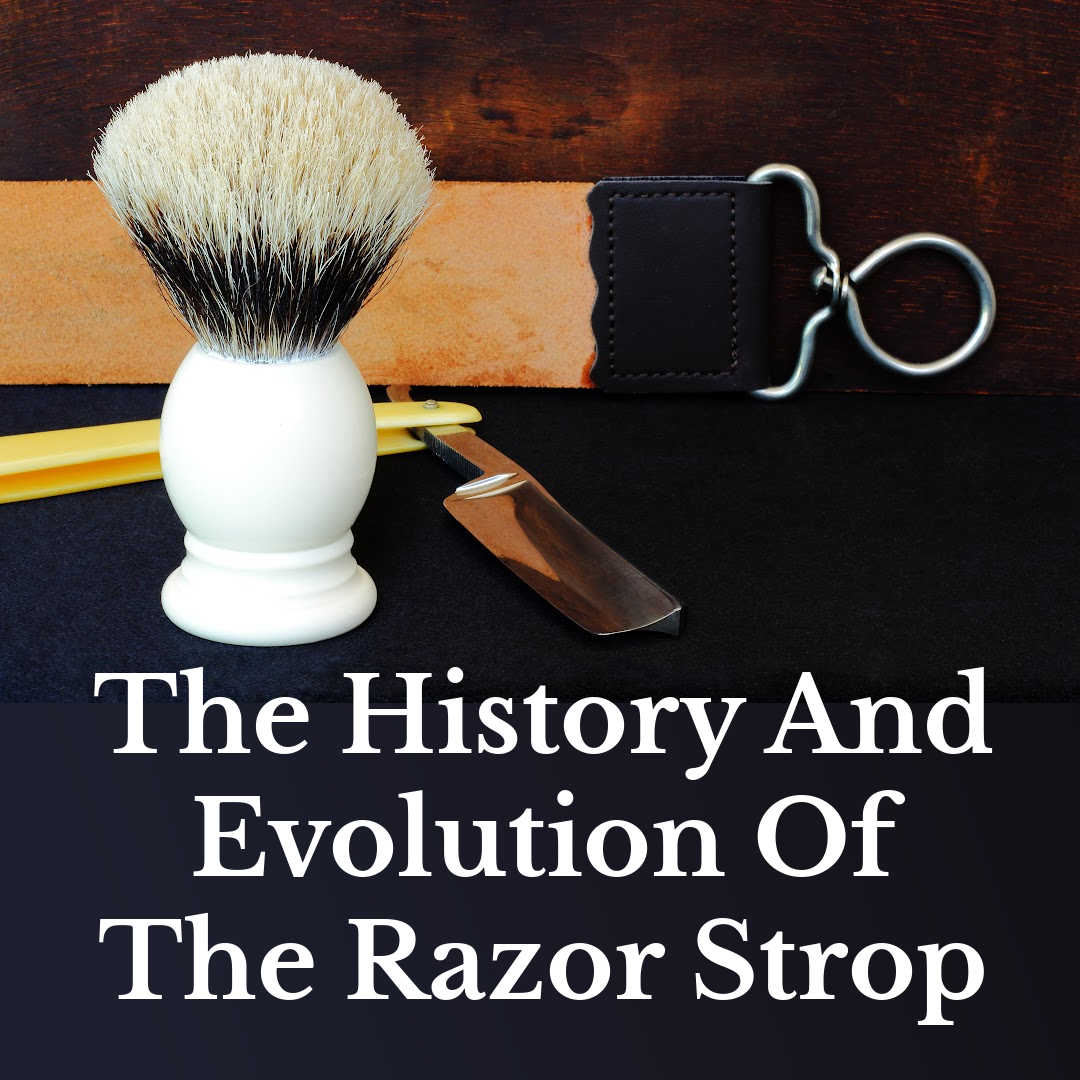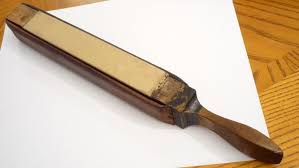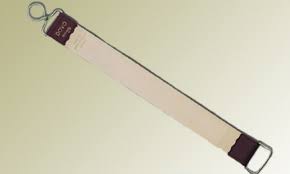
The art of straight razor shaving has come a long way since its humble beginnings, with one key element remaining an essential part of the process: the razor strop. This versatile tool, known for polishing straight razor blades, boasts a rich history that dates back hundreds of years.
In this blog post we’ll explore the origins and evolution of the iconic razor strop – from early straight examples to modern designs tailored for today’s sophisticated wet shavers.
Key Takeaways
- The razor strop has a rich history that dates back to ancient civilizations and remains an essential tool in the wet shaving process.
- Razor strops are made using various materials such as leather, denim, or balsa wood with each having its own unique benefits.
- Straight razors require regular maintenance through stropping on a well-prepared surface to keep them sharp. A proper technique must be employed when using a razor strop to ensure effectiveness.
- Despite innovations in modern grooming tools and techniques, traditional leather remains the most popular material used for making quality razor strops preferred by experienced wet shavers.
What Is A Razor Strop?
The razor strop is a crucial tool for wet shavers as it helps to straighten and polish the blade, creating a sharper edge that can provide a smooth and comfortable shave. It typically consists of a strip of leather, canvas or other materials that are glued onto a wooden paddle or hung from a hook.
The strop’s purpose is to realign the microscopic burrs on the edge of the razor blade that occur after shaving to keep it sharp and ready for use. To use a strop, you simply pull the blade across its surface with light pressure, alternating sides until you achieve the desired sharpness.
Wet-shaving enthusiasts who appreciate traditional methods continue to rely on this timeless accessory as part of their grooming routine.
Evolution Of Razor Strops Over Time
Razor strops have come a long way from their early beginnings as simple leather strips, with other materials like canvas, denim fabric and balsa wood being introduced over time to better serve the needs of wet shavers.
Early Leather Strops
Early leather strops were an essential part of the grooming experience for men in the 18th and 19th centuries. Barbers used strops made from old harnesses to sharpen their straight razors, which helped them achieve a smoother shave.
Leather strops have stood the test of time due to their durability and effectiveness in polishing the blade’s edge before shaving. Today, many traditional wet shavers still use handmade leather strops that are crafted with care by skilled artisans.
Introduction Of Other Materials
As the use of straight razors became more widespread during the 19th century, other materials were introduced as alternatives to leather for strop manufacturing. Loom strops, made from woven fabric materials, gradually grew in popularity and provided a flat surface for razor maintenance.

Paddle strops, which consisted of a wooden block with a leather surface attached to it, also began to appear on the market.
However, despite these innovative new designs that emerged over time, traditional leather remains the most popular material used in razor strop production today. Many experienced wet shavers still choose handmade leather strops because they provide excellent results and have been used reliably for generations.
Modern Razor Strop Designs And Techniques
Modern razor strop designs and techniques have significantly improved since their first appearance. The introduction of new materials like denim fabric, balsa wood, and synthetic leather has allowed for greater flexibility in design.
For instance, loom strops are a modern variant that uses tightly woven linen or canvas to create a smoother sharpening surface.
In addition to new materials, advancements in technology have led to more innovative techniques being implemented with razor strops. The use of diamond sprays or pastes during stropping enhances the honing process by allowing blades to be polished with a finer edge than ever before.
Razor enthusiasts continue innovating on different aspects of the shaving process and creating custom-designed razor strops based on individual preferences.
Materials Used In Razor Strops

Razor strops are made using a variety of materials, each with its own unique characteristics and benefits. Understanding the different materials used in razor strops can help you choose the right one for your shaving needs. Here are some of the most common materials used in razor strops:
- Leather: Leather is perhaps the most popular material for razor strops due to its ability to finely polish the edge of the blade. Cowhide, horsehide, and kangaroo leather are all popular choices.
- Canvas: Canvas is another common material used in razor strops, as it provides an excellent surface for removing burrs and smoothing out any imperfections on the blade’s edge by warming it up with friction. However many modern wet shavers now use canvas only with a strop paste (more on this later).
- Denim Fabric: Some people use denim fabric instead of canvas because it has a coarser weave and helps remove excess metal from the razor’s edge.
- Balsa Wood: Balsa wood is another popular choice for knife lovers because it’s soft, lightweight, and ideal for stropping razors. This is another material often used with strop pastes.
- Compressed Fabric: This type of material is composed of multiple layers of denim or cotton flannel compressed together and then mounted onto a flat board or paddle.
- Vegan: A relatively new alternative to leather strops uses synthetic materials with leather-like properties.
Regardless of which type of material you choose for your razor strop, remember that frequent usage and proper technique are essential to keeping your blades sharp and in good condition.
How To Use A Razor Strop

A razor strop is an important tool in maintaining a sharp straight razor for a clean and smooth shave. Here are some tips on how to use a razor strop effectively:
- Start with a clean and dry strop: Ensure that the strop is free from any debris or moisture before using it.
- Hold the strop tightly: Grasp the handle of the strop firmly with one hand (or attach it to a solid surface) and hold the loose end of the strap with the other hand. There should be a small amount of “slack.”
- Place the razor on the strop: With the blade facing away from you, place the razor on the leather side of the strop at an angle of about 30 degrees.
- Strop in a back-and-forth motion: Using gentle pressure, stroke the razor along the length of the strop, moving it away from you then towards you, without lifting off it.
- Flip over and repeat: Once you reach the end of one side of your blade, flip it over by its spine (so that its spine faces downwards) – now stropping it again in this orientation.
- Repeat strokes: Repeat 20 to 25 times for each side (50 to 70 passes total) by making complete strokes back and forth across your sharpening surface.
Pastes And Conditioning oils
Adding a small amount of honing paste onto some strop surfaces occasionally (every 10-15 shaves) can help align the blade’s surface after it starts to tug. But don’t use a paste on your main strop: pastes are very difficult to remove. Use another strop with a paste.
Strop Conditioning Oils
It’s important to clean and recondition your stropping tool regularly – this means inspecting it for wear & tear which could compromise effectiveness while also removing any debris/dirt which may get stuck within grooves, folds etc. Additionally you can condition natural leather surfaces every 100 or so uses with oils like neatsfoot oil (which help preserve moisture) while avoiding prolonged exposure to direct sunlight/internal heating sources which can cause premature aging/fading/colors loss over time. Some users simply rub their hands on the surface and let their skin oils do the work.
By regularly using a razor strop as part of your shaving routine, you can ensure your straight razors stay sharp enough to provide you with an efficient, gentle shave every time while minimizing nicks and irritation caused by dull blades.
Conclusion: The Timeless Importance Of The Razor Strop In Shaving History
In conclusion, the razor strop has played a significant role in the history and evolution of shaving. From its early use by ancient civilizations to its importance during the peak of straight razor popularity in the 18th and 19th centuries, it’s clear that this tool has become an integral part of male grooming.
Though safety razors have taken over, straight razor enthusiasts still understand the value of a good strop in maintaining their blades’ sharpness and longevity.
About the authors: This article was jointly written by Mark “Mantic59” and Otto Wright, a wet shaver and freelance author, with additional input from Joe Borrelli.

I have found original strops are a bit hard to find. Why could you use an older wider leather belt as a strop
Comments are closed.